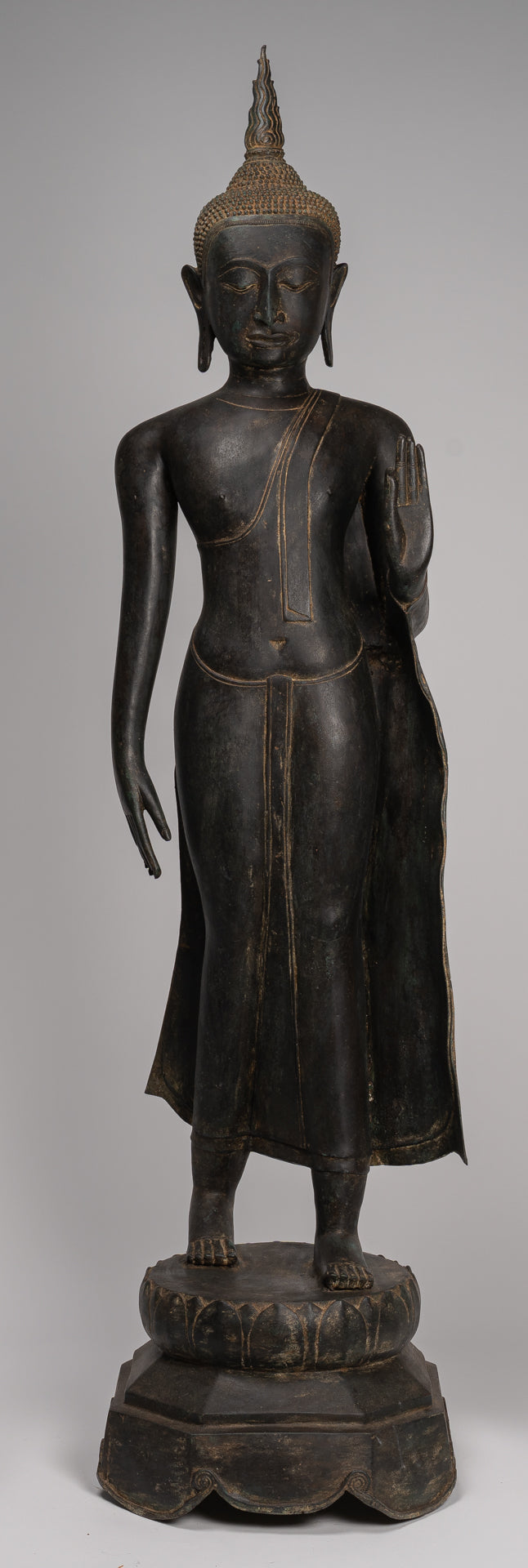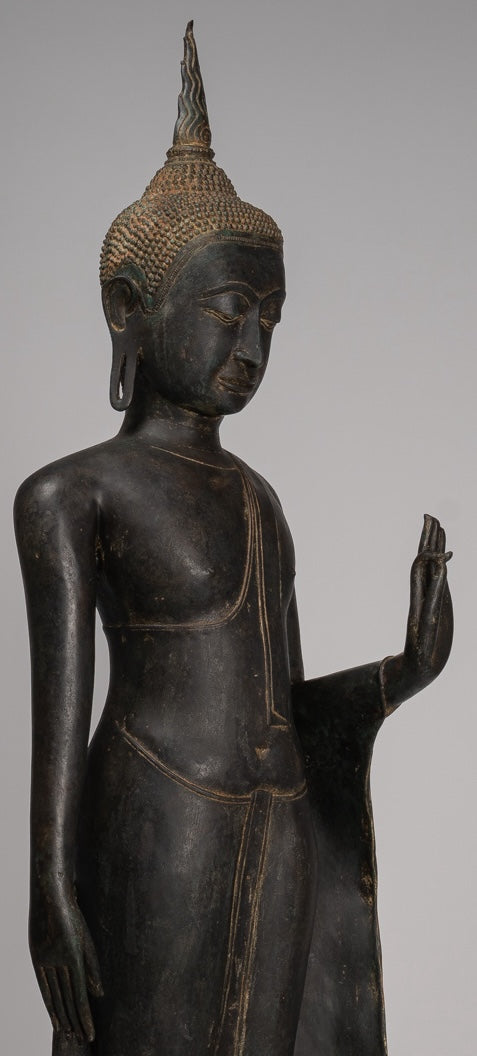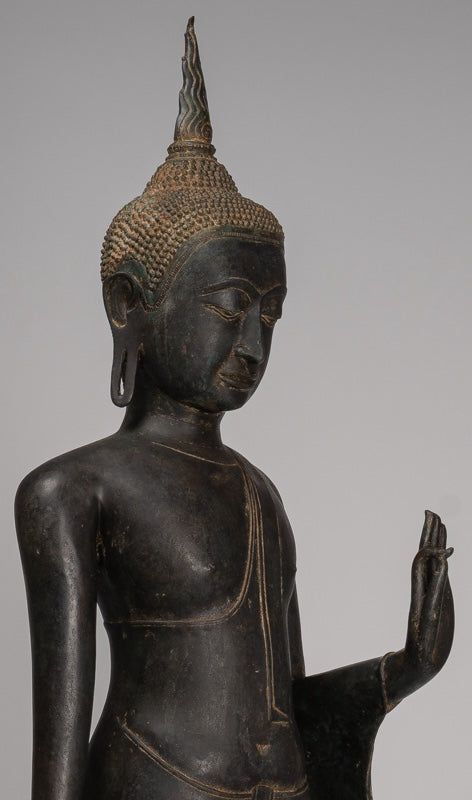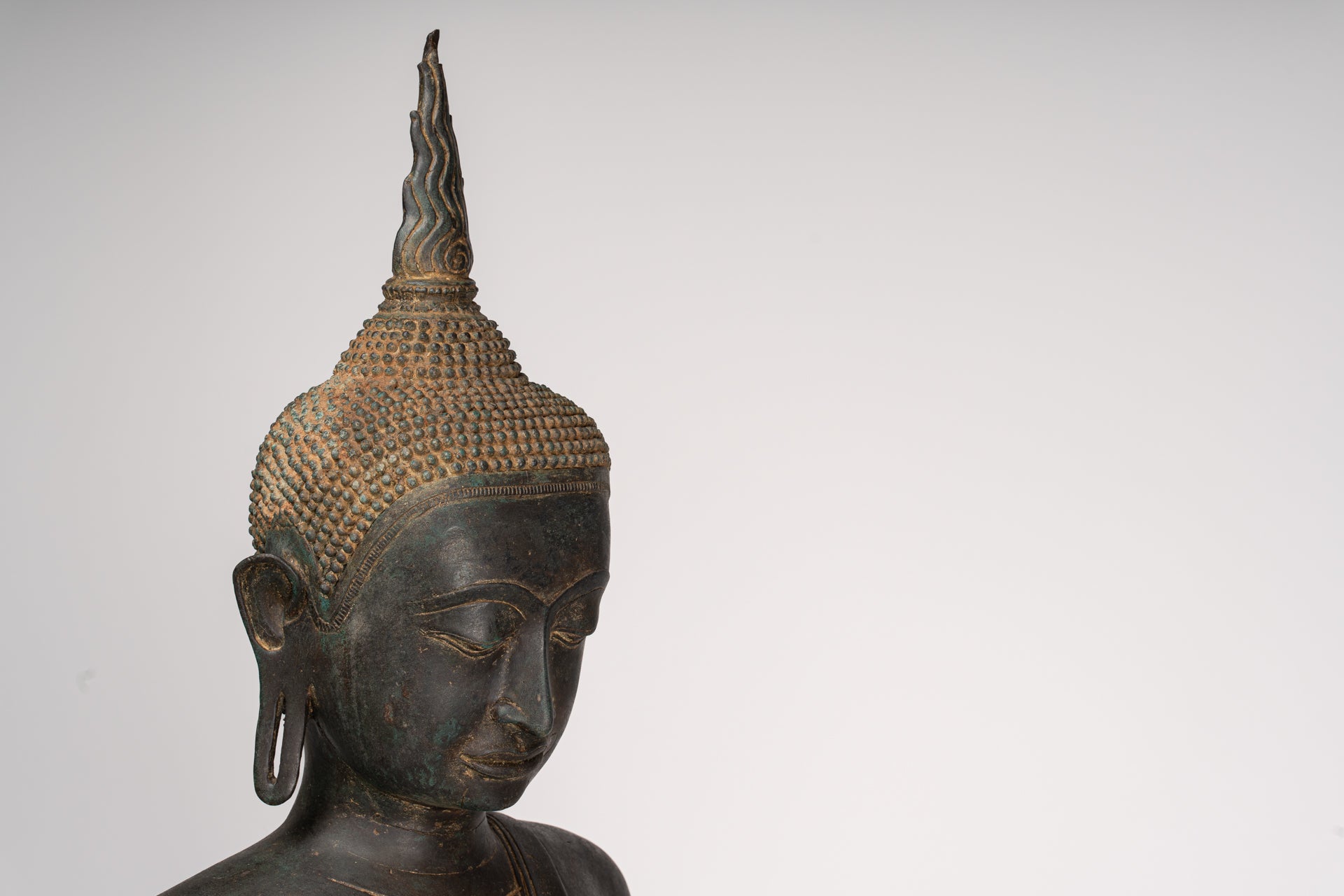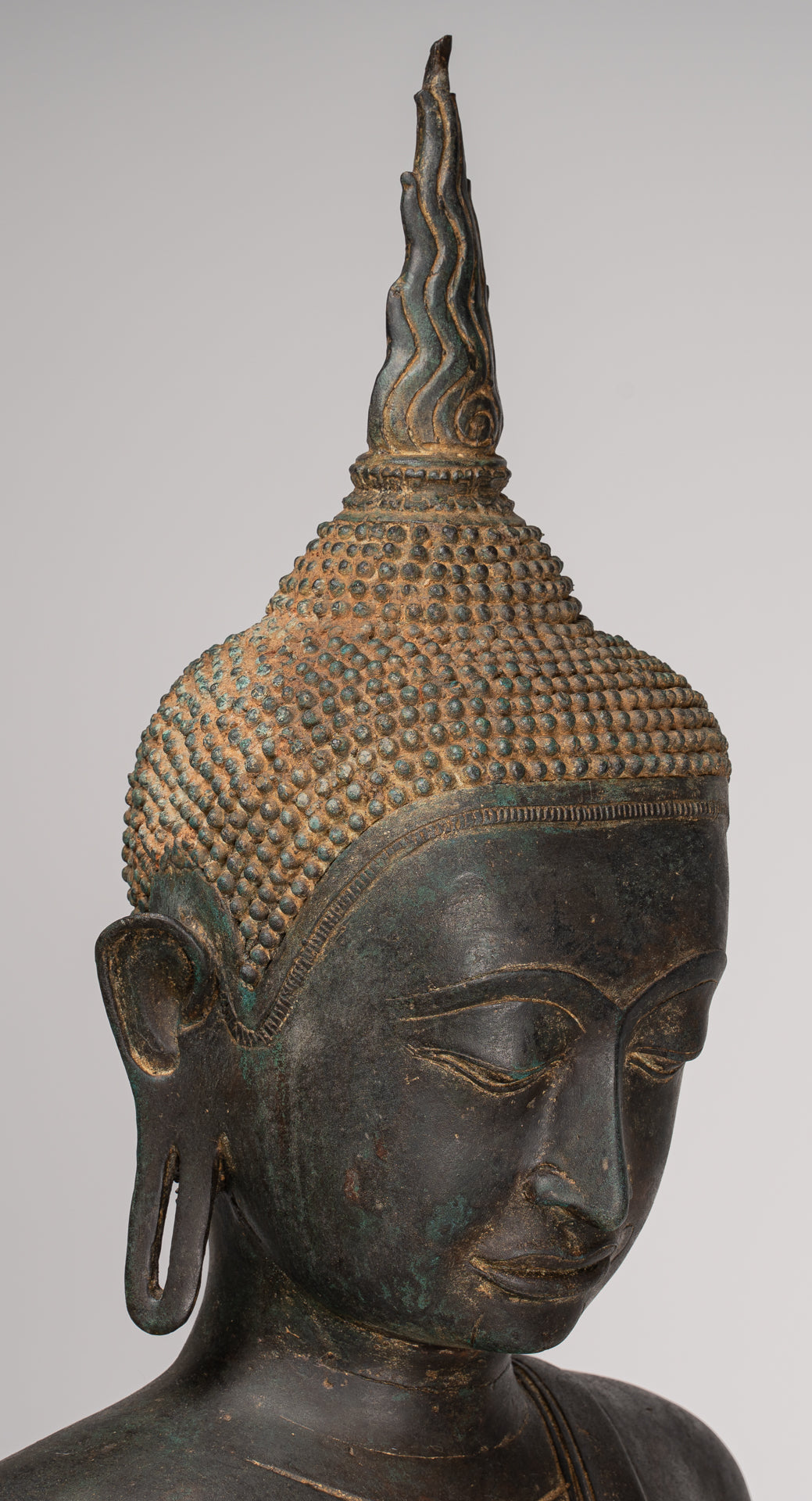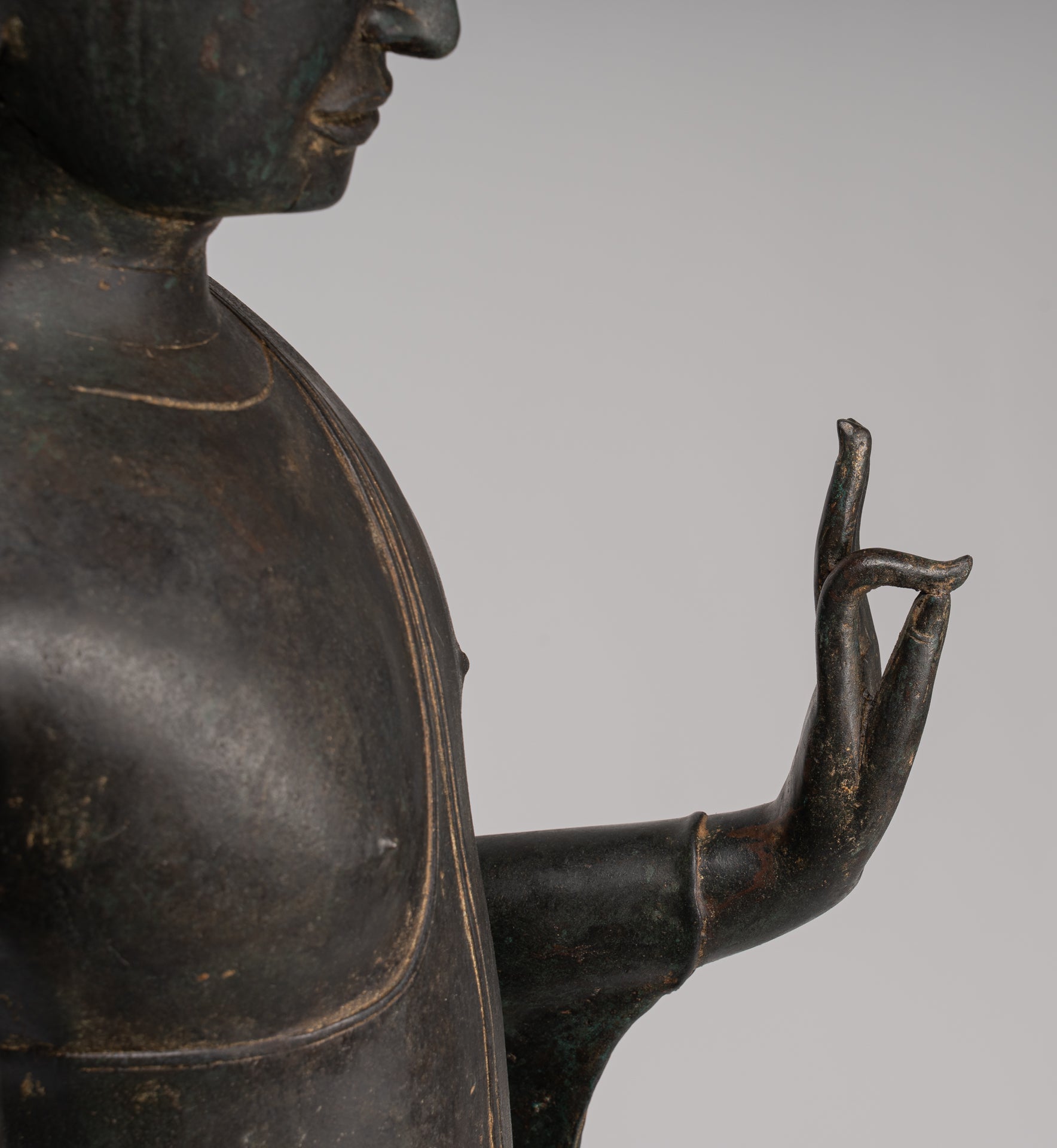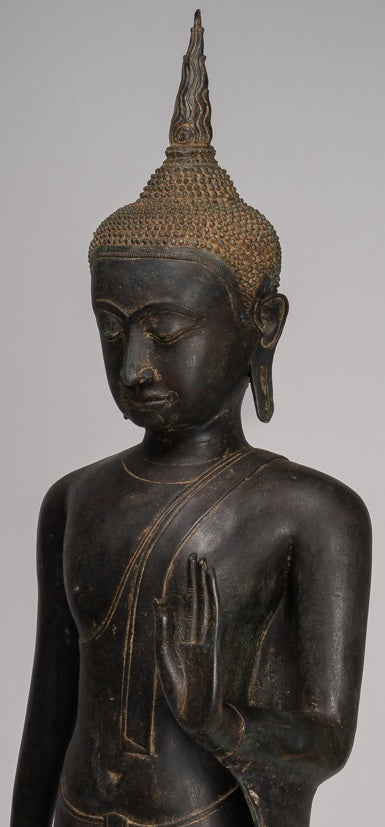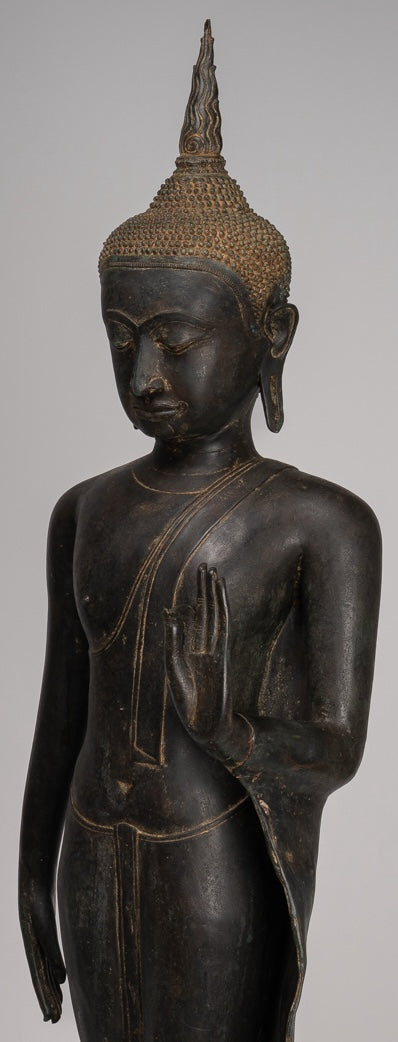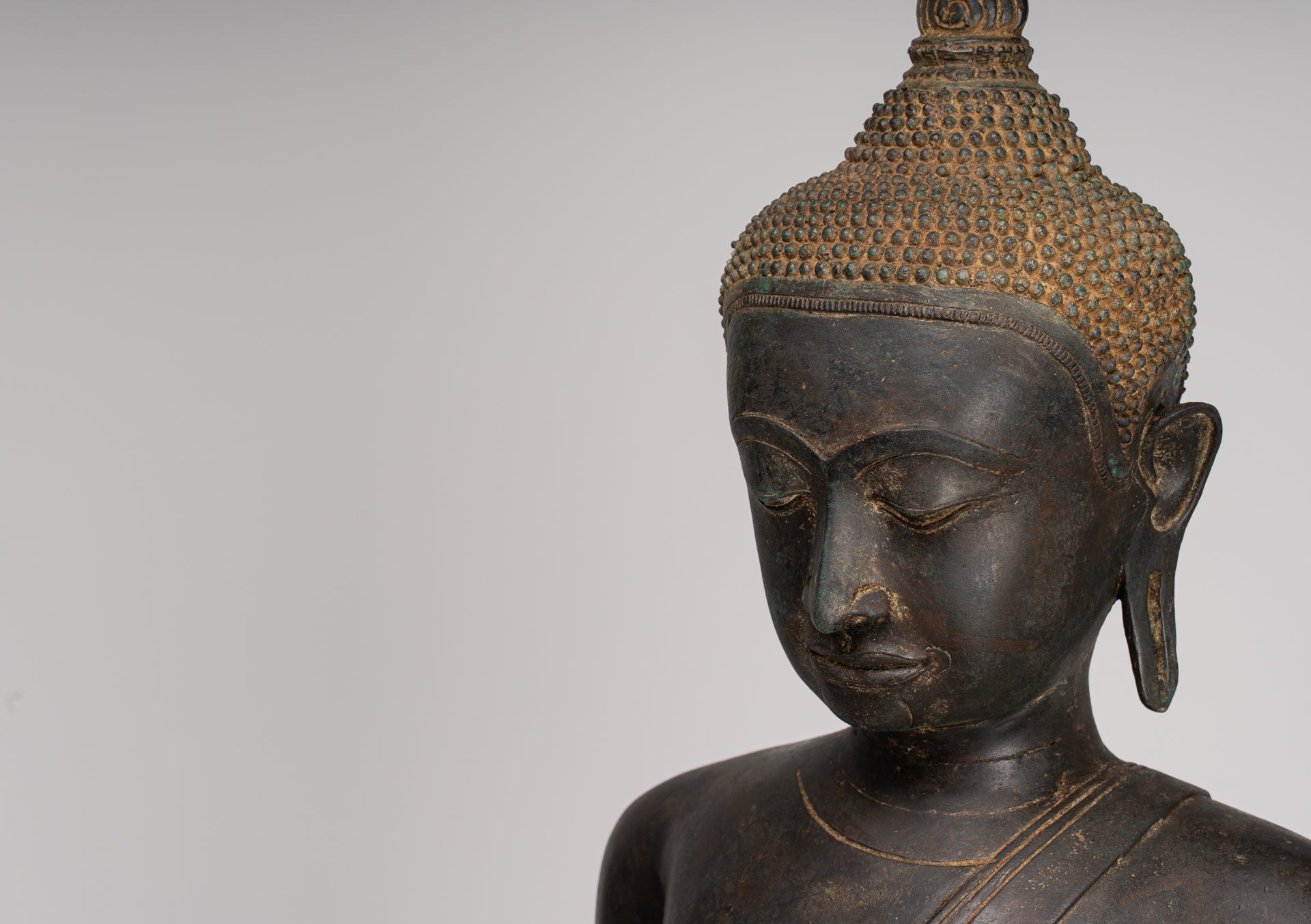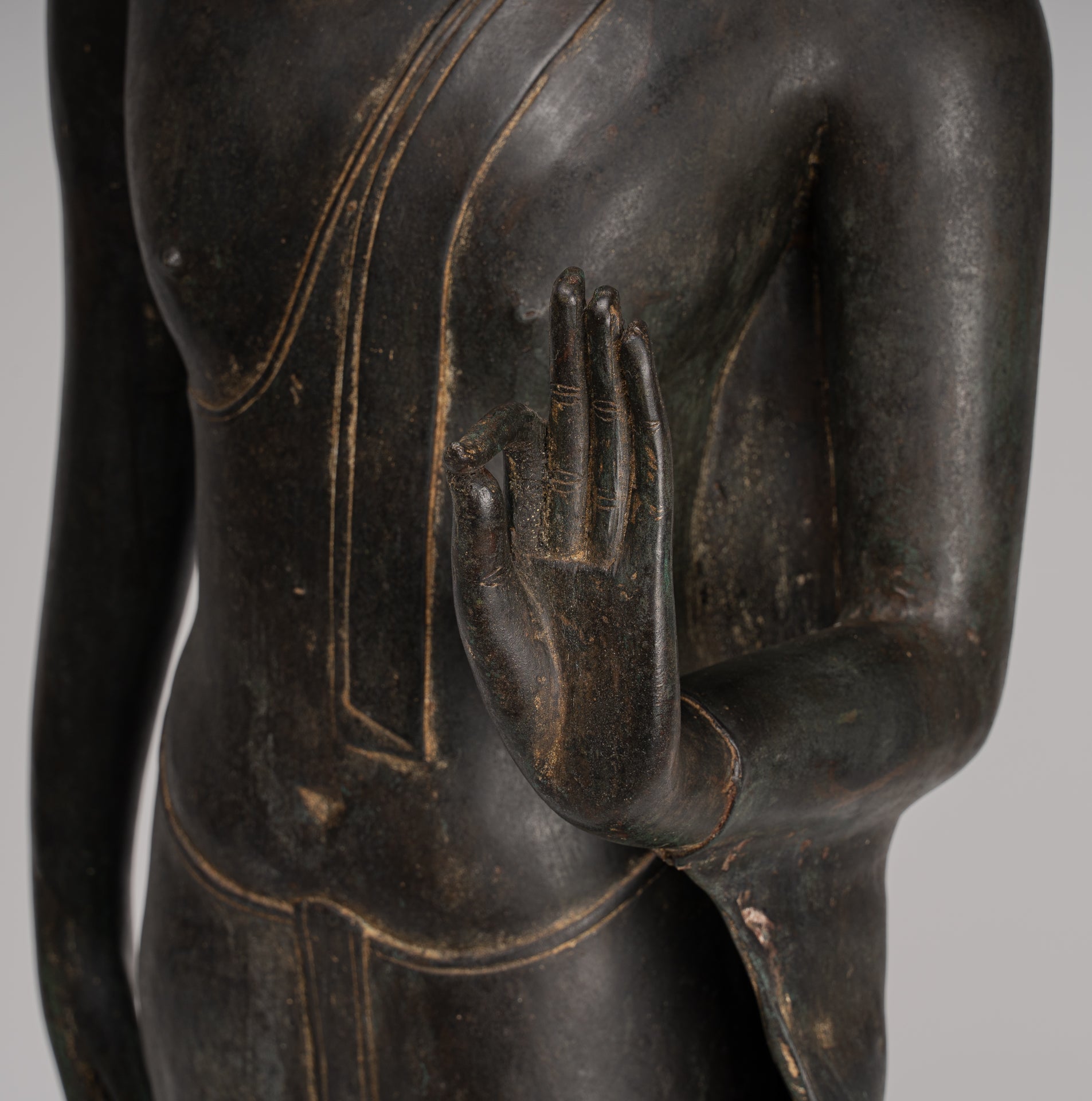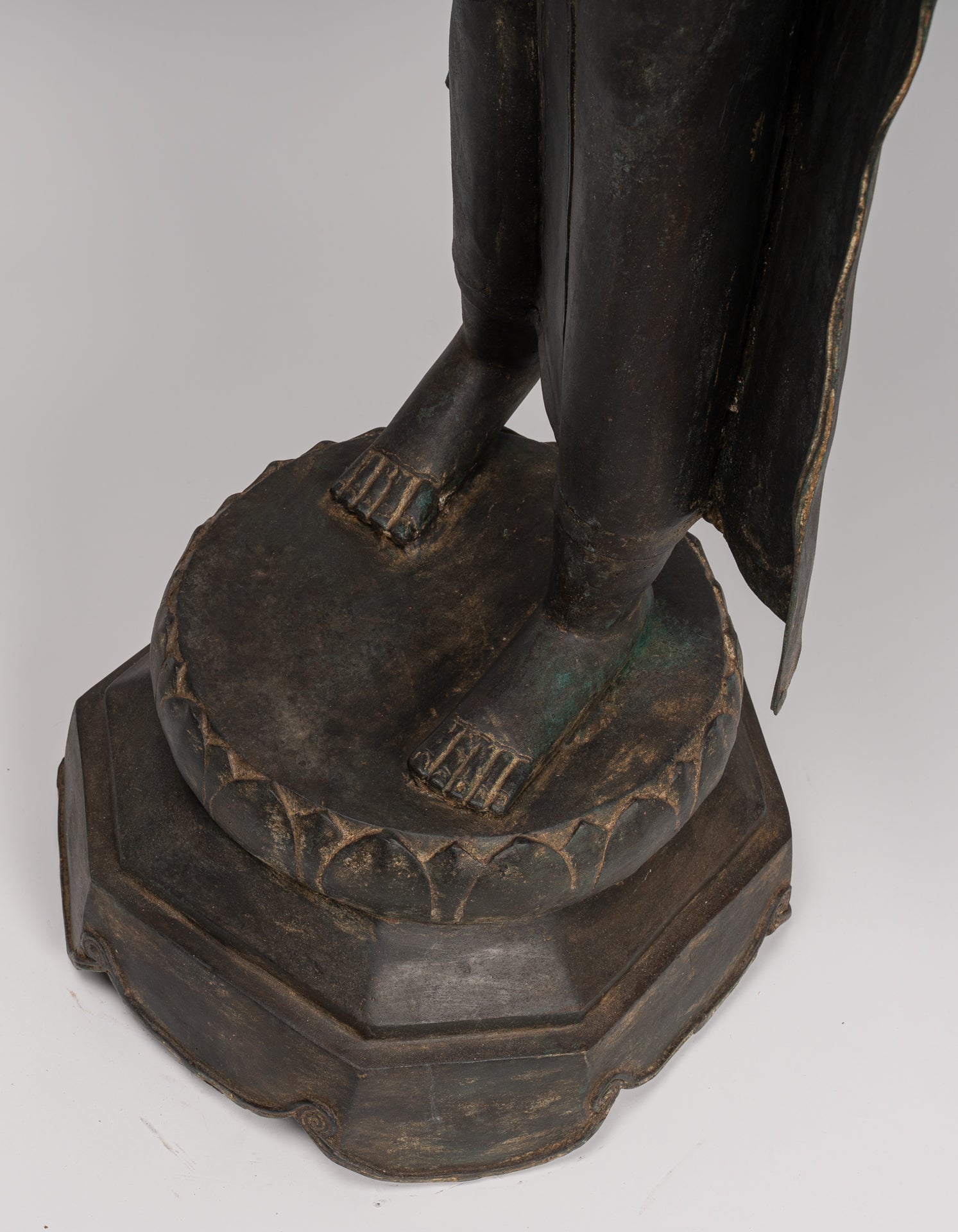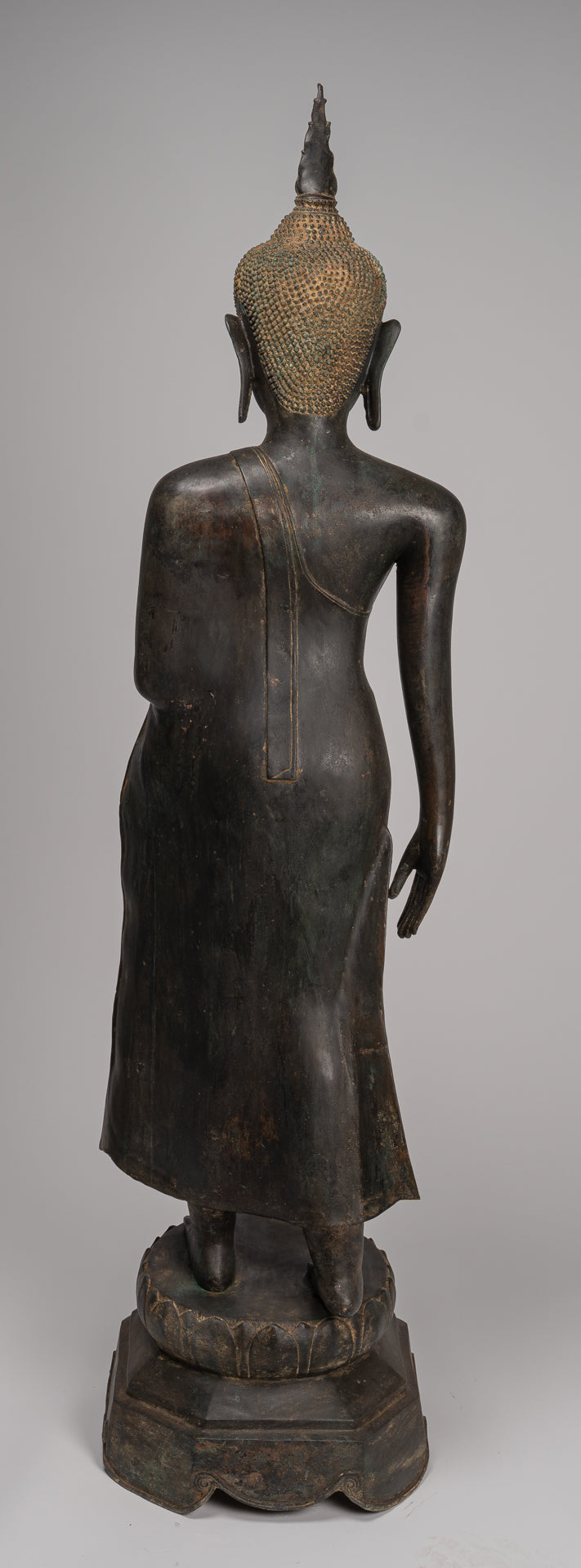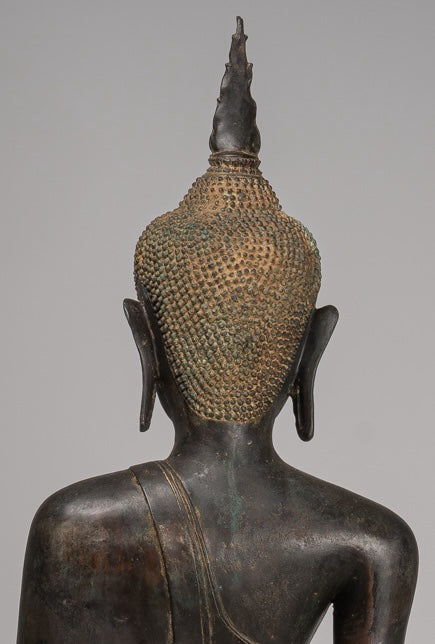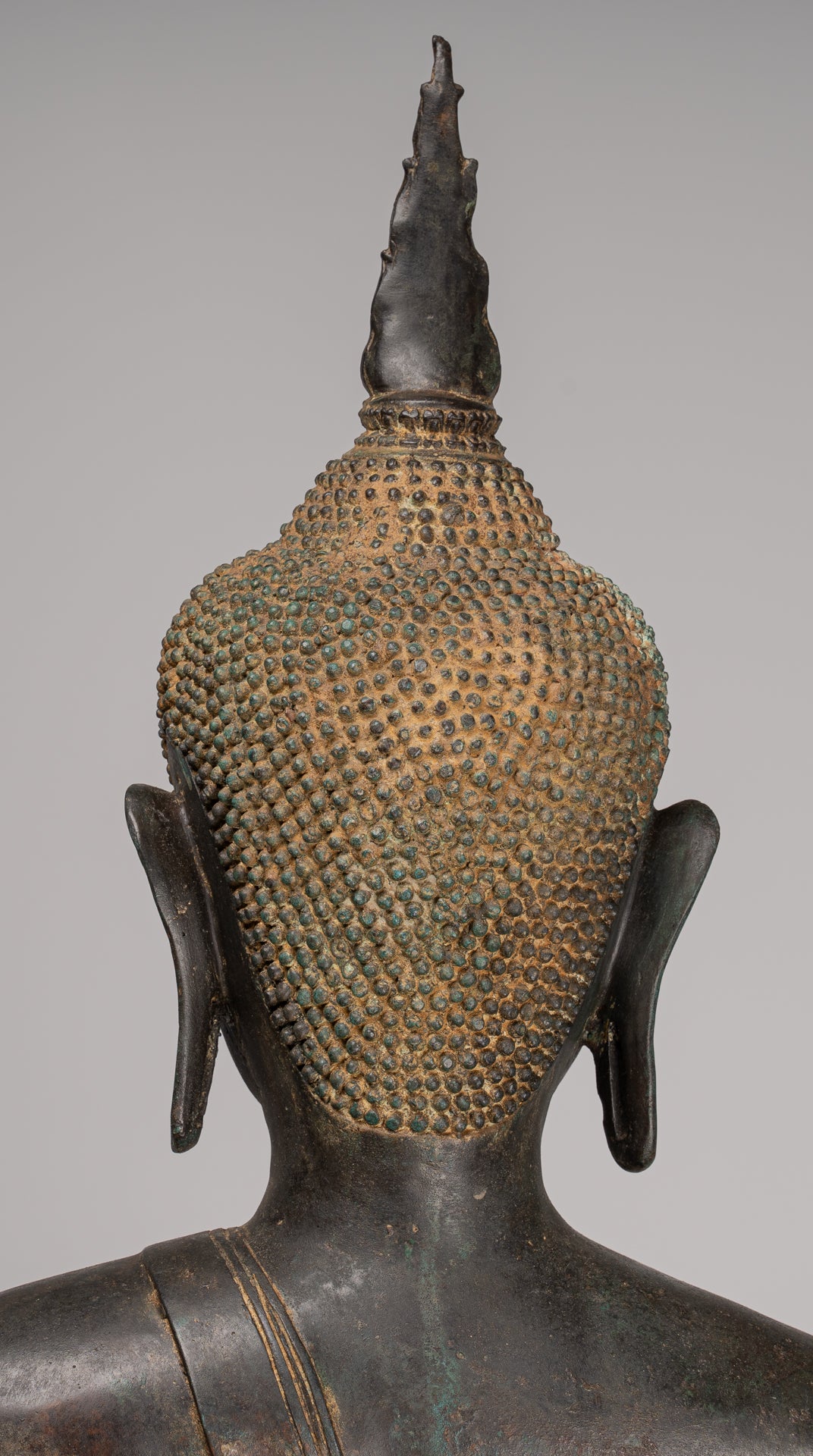-
Antique Thai Style Chiang Rung Large Bronze Protection Walking Buddha Statue - 150cm/60"
Measures (Height) 150cm/60"
A large antique Thai style Walking Buddha from Thailand, in the Chiang Rung style.
The Buddha is depicted walking after his enlightenment on a circular lotus base. The lotus flower represents purity, compassion and the giving of great joy to all.
The large flaming ushnisha protuberance on top of his head, typical of the Chiang Rung period, symbolizes his high level of spiritual development.
Here, the Walking Buddha is depicted as a serene and upright figure, clothed in monastic robes. The Buddha's left hand is extended forward with the palm facing upward, while the right hand remains at the side. The posture and gesture convey a sense of purpose and mindfulness.
The Walking Buddha represents the Buddha engaged in walking meditation (kinhin in Zen Buddhism), a practice integral to the Buddhist path. Walking meditation is a deliberate and mindful practice that involves walking slowly and attentively, being fully present in each step. It is a method of cultivating mindfulness, concentration, and insight.
The Walking Buddha also embodies a sense of dynamic equanimity, signifying that enlightenment is not limited to stillness but can be realized in the midst of life's activities. It reflects the idea that one can attain spiritual awakening and maintain mindfulness while engaging in daily routines and responsibilities.
The balanced posture of the Walking Buddha symbolizes the middle path, a core concept in Buddhism. It teaches the importance of avoiding extremes and finding harmony in all aspects of life.
The act of walking itself is a reminder of the impermanent nature of existence. Each step taken by the Walking Buddha signifies the continuous cycle of change and the impermanence of all things, a fundamental teaching in Buddhism.
This Chiang Rung style of Buddha is a distinctive and historically significant artistic tradition of Buddha statues in northern Thailand. This style is characterized by the unique aesthetic features, intricate details, and profound spiritual symbolism.
The Chiang Rung style originated in the north of Thailand, near the borders of Myanmar (Burma) and Laos. The area was a significant centre of Buddhist art and culture during the Lanna period, which spanned from the 13th to the 18th centuries.
Buddhist art in this region was influenced by the Theravada tradition and was characterized by its unique interpretations of Buddha images. Chiang Rung style sculptures have also been found in neighbouring regions, such as Laos and parts of Myanmar, reflecting the cultural exchange and impact of Chiang Rung art.
The Buddha has a peaceful countenance with downcast introspective eyes and a firm brow. His earlobes are stretched long from a youth spent as a prince wearing heavy gold earrings. His robe is draped to leave the right shoulder bare, and a portion of the garment that covers the left wrist falls behind the figure. The lower hem of the robe comes all the way down so that the under-cloth or skirt is completely covered.
The Buddha's face is serene, with a naturalistic and warm expression; his ushnisha is topped by tightly wound hair curls. His serene almost pensive face displays down cast eyes, a single arched eyebrow and aquiline nose. Beauty lines can be seen upon his neck. His earlobes are stretched long from a youth spent as a prince wearing heavy gold earrings.
The peaceful countenance of Lord Buddha exudes harmony. The Abhaya mudra "gesture of fearlessness" is a mudra (gesture) that offers protection, reassurance and safety. Dispelling fear and according divine protection and bliss in many Indian religions. The left hand is held up and the palm is facing outwards. This is one of the earliest mudras found depicted on a number of Hindu, Buddhist and Jain images.
The image of the Walking Buddha is a powerful representation of mindfulness, balance, and the dynamic nature of the spiritual journey in Buddhism. It serves as a reminder that enlightenment is not limited to static moments of contemplation but can be realized in the midst of life's movements and activities. The Walking Buddha invites practitioners to embrace mindfulness, engage in daily life with equanimity, and cultivate the qualities of compassion and wisdom on their path toward spiritual awakening.
The sculpture provides the perfect traditional in appearance Buddha to bring serenity and timeless style to your home, office or sacred space.
To aid with safe transport your Buddha will be packed in a wood crated before shipping.
SATISFACTION GUARANTEE - We have been offering SE Asian Art, through our website and eBay, for many years and are proud of the reputation we have developed for fair and honest listings. However, if for any reason, whatsoever, you are unhappy with your purchase please just let us know and we will provide a full refund. We want you to be 100% happy with your purchase.
-
The majority of orders will be shipped with DHL. This is a secure, express and fully tracked service.
Items less than 2Kg we typically ship using Royal Mail.
Once we receive your order we try to ship all orders the same or next working day.
Large and/or fragile pieces requiring palletising, specialist crating and/or extra packaging may take a little longer. Palletised shipments will be delivered curbside.
All orders over 35 GBP will be shipped free of charge.

-
We genuinely hope that all purchases delight.
However, if they do not, regardless of reason, we will refund all orders upon receipt of the unwanted item. Just notify us within 14 days of receiving your order that you wish to make a return and send the piece back to us with 30 days of delivery.
If you’re looking to buy a Ganesha statue in the UK, you’ll quickly discover a world of exquisite craftsmanship, deep symbolism, and cultural heritage. The Lord Ganesha statue—beloved as the remover of obstacles and the god of wisdom—holds a special place in homes and temples around the world.
But finding the perfect piece, whether carved from wood, shaped in stone, or cast in bronze, requires an understanding of both artistic technique and spiritual significance.


